Boeing 727
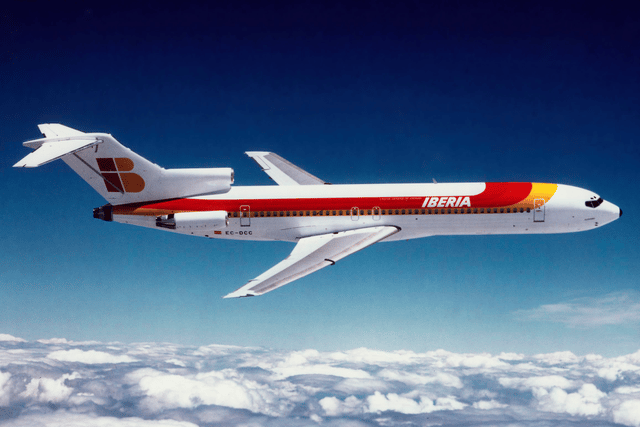
Boeing 727

| Boeing 727 | |
|---|---|
| Iberia 727-200 | |
| Role | Narrow-body jet airliner |
| National origin | United States |
| Manufacturer | Boeing Commercial Airplanes |
| First flight | February 9, 1963 |
| Introduction | February 1, 1964, with Eastern Air Lines |
| Status | Limited to freighters and executive use[1] |
| Primary user | Kalitta Charters Líneas Aéreas Suramericanas |
| Produced | 1962–1984 |
| Number built | 1,832[6] |
| Unit cost | |
The Boeing 727 is an American midsized, narrow-body three-engined jet aircraft built by Boeing Commercial Airplanes from the early 1960s to 1984.[6] It can carry 149 to 189 passengers and later models can fly up to 2,700 nautical miles (5,000 km) nonstop. Intended for short and medium-length flights, the 727 can use relatively short runways at smaller airports. It has three Pratt & Whitney JT8D engines below a T-tail, one on each side of the rear fuselage with a center engine that connects through an S-duct to an inlet at the base of the fin. The 727 is the only Boeing trijet,[8] as a commercial design entering production.
The 727 followed the 707, a quad-jet airliner, with which it shares its upper fuselage cross-section and cockpit design. The 727-100 first flew in February 1963 and entered service with Eastern Air Lines in February 1964; the stretched 727-200 flew in July 1967 and entered service with Northeast Airlines that December. The 727 became a mainstay of airlines' domestic route networks and was also used on short- and medium-range international routes. Passenger, freighter, and convertible versions of the 727 were built.
The highest production rate of the 727 was in the 1970s; the last 727 was completed in 1984. As of July 2018, a total of 44 Boeing 727s (2× 727-100s and 42× -200s) were in commercial service with 23 airlines,[9] plus a few more in government and private use. Airport noise regulations have led to 727s being equipped with hush kits. Since 1964, there have been 118 fatal incidents involving the Boeing 727. Successor models include variants of the 737 and the 757-200. The last commercial passenger flight of the type was in January 2019.[10]
| Boeing 727 | |
|---|---|
| Iberia 727-200 | |
| Role | Narrow-body jet airliner |
| National origin | United States |
| Manufacturer | Boeing Commercial Airplanes |
| First flight | February 9, 1963 |
| Introduction | February 1, 1964, with Eastern Air Lines |
| Status | Limited to freighters and executive use[1] |
| Primary user | Kalitta Charters Líneas Aéreas Suramericanas |
| Produced | 1962–1984 |
| Number built | 1,832[6] |
| Unit cost | |
Development
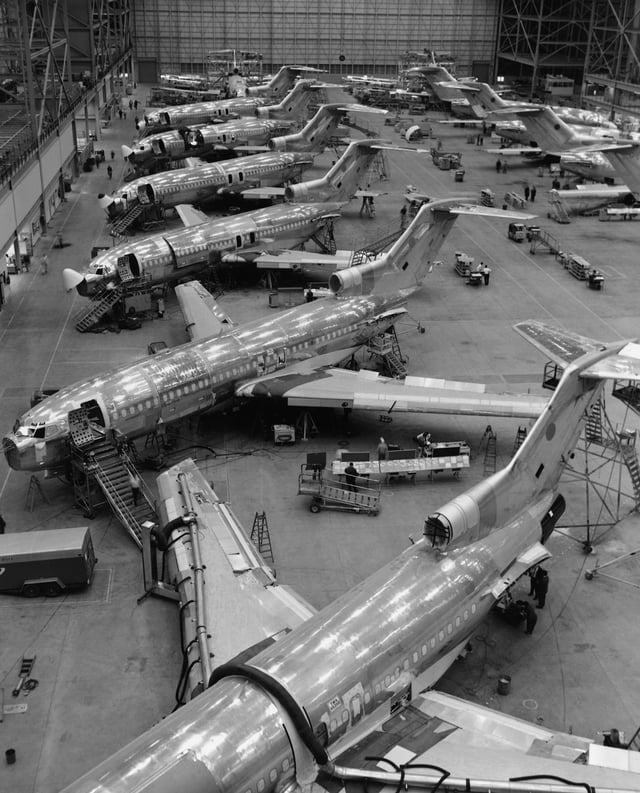
Production of the 727
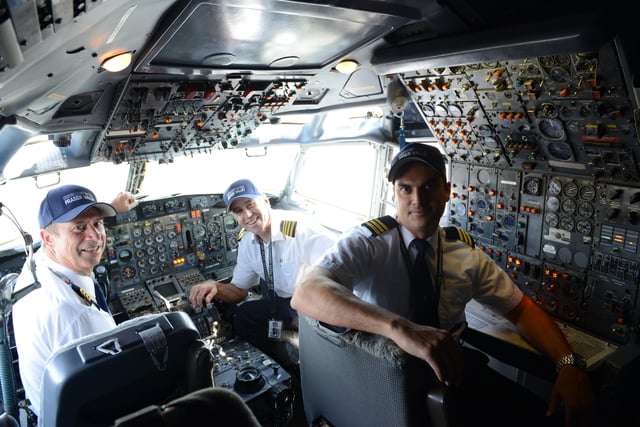
Three-crew cockpit
The Boeing 727 design was a compromise among United Airlines, American Airlines, and Eastern Air Lines; each of the three had developed requirements for a jet airliner to serve smaller cities with shorter runways and fewer passengers.[11] United Airlines requested a four-engine aircraft for its flights to high-altitude airports, especially its hub at Stapleton International Airport in Denver, Colorado.[11] American Airlines, which was operating the four-engined Boeing 707 and Boeing 720, requested a twin-engined aircraft for efficiency. Eastern Airlines wanted a third engine for its overwater flights to the Caribbean, since at that time twin-engine commercial flights were limited by regulations to routes with 60-minute maximum flying time to an airport (see ETOPS). Eventually, the three airlines agreed on a trijet design for the new aircraft.[11]
In 1959, Lord Douglas, chairman of British European Airways (BEA), suggested that Boeing and de Havilland Aircraft Company (later Hawker Siddeley) work together on their trijet designs, the 727 and D.H.121 Trident, respectively.[12] The two designs had a similar layout, the 727 being slightly larger. At that time Boeing intended to use three Allison AR963 turbofan engines, license-built versions of the Rolls-Royce RB163 Spey used by the Trident.[13][14] Boeing and de Havilland each sent engineers to the other company's locations to evaluate each other's designs, but Boeing eventually decided against the joint venture.[15] De Havilland had wanted Boeing to license-build the D.H.121, while Boeing felt that the aircraft needed to be designed for the American market, with six-abreast seating and the ability to use runways as short as 4,500 feet (1,400 m).[16]
In 1960, Pratt & Whitney was looking for a customer for its new JT8D turbofan design study, based on its J52 (JT8A) turbojet,[17] while United and Eastern were interested in a Pratt & Whitney alternative to the RB163 Spey.[18] Once Pratt & Whitney agreed to go ahead with development of the JT8D, Eddie Rickenbacker, chairman of the board of Eastern, told Boeing that the airline preferred the JT8D for its 727s. Boeing had not offered the JT8D, as it was about 1,000 lb (450 kg) heavier than the RB163, though slightly more powerful; the RB163 was also further along in development than the JT8D. Boeing reluctantly agreed to offer the JT8D as an option on the 727, and it later became the sole powerplant.[19]
With high-lift devices[20] on its wing, the 727 could use shorter runways than most earlier jets (e.g. the 4800-ft runway at Key West).
Later 727 models were stretched to carry more passengers[21] and replaced earlier jet airliners such as the Boeing 707 and Douglas DC-8, as well as aging propeller airliners such as the DC-4, DC-6, DC-7, and the Lockheed Constellations on short- and medium-haul routes.
Design
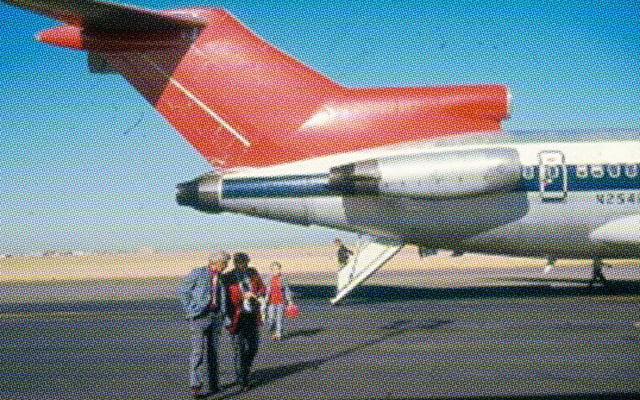
The 727 tail and rear airstairs
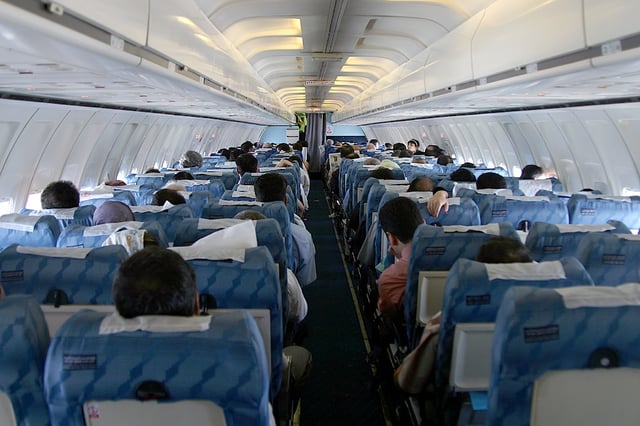
six-abreast seating
The airliner's middle engine (engine 2) at the very rear of the fuselage gets air from an inlet ahead of the vertical fin through an S-shaped duct.[23] This S-duct proved to be troublesome in that flow distortion in the duct induced a surge in the centerline engine on the take-off of the first flight of the 727-100.[24] This was fixed by the addition of several large vortex generators in the inside of the first bend of the duct.
The 727 was designed for smaller airports, so independence from ground facilities was an important requirement. This led to one of the 727's most distinctive features: the built-in airstair that opens from the rear underbelly of the fuselage, which initially could be opened in flight.[20] Hijacker D. B. Cooper used this hatch when he parachuted from the back of a 727, as it was flying over the Pacific Northwest. Boeing subsequently modified the design with the Cooper vane so that the airstair could not be lowered in flight.[25] Another innovation was the auxiliary power unit (APU), which allowed electrical and air-conditioning systems to run independently of a ground-based power supply, and without having to start one of the main engines. An unusual design feature is that the APU is mounted in a hole in the keel beam web, in the main landing gear bay.[24] The 727 is equipped with a retractable tailskid that is designed to protect the aircraft in the event of an over-rotation on takeoff. The 727's fuselage has an outer diameter of 148 inches (3.8 m). This allows six-abreast seating (three per side) and a single aisle when 18-inch (46 cm) wide coach-class seats are installed. An unusual feature of the fuselage is the 10-inch (25 cm) difference between the lower lobe forward and aft of the wing as the higher fuselage height of the center section was simply retained towards the rear.
Nosewheel brakes were available as an option to reduce braking distance on landing, which provided reduction in braking distances of up to 150 m.[26]
The 727 proved to be such a reliable and versatile airliner that it came to form the core of many startup airlines' fleets. The 727 was successful with airlines worldwide partly because it could use smaller runways while still flying medium-range routes. This allowed airlines to carry passengers from cities with large populations, but smaller airports to worldwide tourist destinations. One of the features that gave the 727 its ability to land on shorter runways was its clean wing design.[20] With no wing-mounted engines, leading-edge devices (Krueger, or hinged, flaps on the inner wing and extendable leading edge slats out to the wingtip) and trailing-edge lift enhancement equipment (triple-slotted,[27] fowler flaps) could be used on the entire wing. Together, these high-lift devices produced a maximum wing lift coefficient of 3.0 (based on the flap-retracted wing area).[24] The 727 was stable at very low speeds compared to other early jets, but some domestic carriers learned after review of various accidents that the 40-degree flap setting could result in a higher-than-desired sink rate or a stall on final approach. These carriers' Pilots' Operation Handbooks disallowed using more than 30° of flaps on the 727, even going so far as installing plates on the flap lever slot to prevent selection of more than 30° of flaps.
Noise

Stage three hush kits
The 727 is one of the noisiest commercial jetliners, categorized as Stage 2 by the U.S. Noise Control Act of 1972, which mandated the gradual introduction of quieter Stage 3 aircraft. The 727's JT8D jet engines use older low-bypass turbofan technology, whereas Stage 3 aircraft use the more efficient and quieter high-bypass turbofan design. When the Stage 3 requirement was being proposed, Boeing engineers analyzed the possibility of incorporating quieter engines on the 727. They determined that the JT8D-200 engine could be used on the two side-mounted pylons, but the structural changes to fit the larger-diameter engine (49.2 inches (125 cm) fan diameter in the JT8D-200 compared to 39.9 inches (101 cm) in the JT8D-7) into the fuselage at the number two engine location were prohibitive.
Current regulations require that a 727 in commercial service must be retrofitted with a hush kit to reduce engine noise to Stage 3 levels. One such hush kit is offered by FedEx,[28] and has been purchased by over 60 customers.[29] Aftermarket winglet kits, originally developed by Valsan Partners and later marketed by Quiet Wing Corp.[30] have been installed on many 727s to reduce noise at lower speeds, as well as to reduce fuel consumption. In addition, Raisbeck Engineering developed packages to enable 727s to meet the Stage 3 noise requirements. These packages managed to get light- and medium-weight 727s to meet Stage 3 with simple changes to the flap and slat schedules. For heavier-weight 727s, exhaust mixers must be added to meet Stage 3.[30] American Airlines ordered and took delivery of 52 Raisbeck 727 Stage 3 systems. Other customers included TWA, Pan Am, Air Algérie, TAME, and many smaller airlines.[31][32]
Since September 1, 2010, 727 jetliners (including those with a hush kit) are banned from some Australian airports because they are too loud.[33]
Operational history
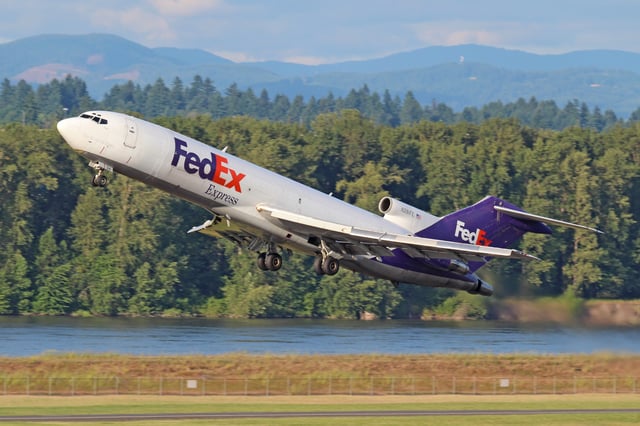
A FedEx Express 727-233 departs Portland International Airport

Northwest Airlines retired its last 727 in June 2003
In addition to domestic flights of medium range, the 727 was popular with international passenger airlines.[21] The range of flights it could cover (and the additional safety added by the third engine) meant that the 727 proved efficient for short- to medium-range international flights in areas around the world. Prior to its introduction, four-engined jets or propeller-driven airliners were required for transoceanic service.
The 727 also proved popular with cargo and charter airlines. FedEx Express introduced 727s in 1978.[34] The 727s were the backbone of its fleet until the 2000s; FedEx began replacing them with Boeing 757s in 2007.[34] Many cargo airlines worldwide employ the 727 as a workhorse, since, as it is being phased out of U.S. domestic service because of noise regulations, it becomes available to overseas users in areas where such noise regulations have not yet been instituted. Charter airlines Sun Country, Champion Air, and Ryan International Airlines all started with 727 aircraft.
The 727 has proven to be popular where the airline serves airports with gravel, or otherwise lightly improved, runways. The Canadian airline First Air, for example, previously used a 727-100C to serve the communities of Resolute Bay and Arctic Bay in Nunavut, whose Resolute Bay Airport and former Nanisivik Airport both have gravel runways. The high-mounted engines greatly reduce the risk of foreign object damage.
A military version, the Boeing C-22, was operated as a medium-range transport aircraft by the Air National Guard and National Guard Bureau to airlift personnel. A total of three C-22Bs were in use, all assigned to the 201st Airlift Squadron, District of Columbia Air National Guard.[36]
At the start of the 21st century, the 727 remained in service with a few large airlines. Faced with higher fuel costs, lower passenger volumes due to the post-9/11 economic climate, increasing restrictions on airport noise, and the extra expenses of maintaining older planes and paying flight engineers' salaries, most major airlines phased out their 727s; they were replaced by twin-engined aircraft, which are quieter and more fuel-efficient. Modern airliners also have a smaller flight deck crew of two pilots, while the 727 required two pilots and a flight engineer. Delta Air Lines, the last major U.S. carrier to do so, retired its last 727 from scheduled service in April 2003. Northwest Airlines retired its last 727 from charter service in June 2003. Many airlines replaced their 727s with either the 737-800 or the Airbus A320; both are close in size to the 727-200. As of July 2013, a total of 109 Boeing 727s (5× 727-100s and 104× -200s) were in commercial service with 34 airlines;[37] three years later, the total had fallen to 64 airframes (4× 727-100s and 60× -200s) with 26 airlines.[38]
On March 2, 2016, the first 727 produced (N7001U), which first flew on February 9, 1963, made a flight to a museum after extensive restoration. The 727-100 had carried about three million passengers during its years of service. Originally a prototype, it was later sold to United Airlines, which donated it to the Museum of Flight in Seattle in 1991. The jet was restored over 25 years by the museum and was ferried from Paine Field in Everett, Washington to Boeing Field in Seattle, where it was put on permanent display at the Aviation Pavilion.[39][40][41] The Federal Aviation Administration granted the museum a special permit for the 15-minute flight. The museum's previous 727-223, tail number N874AA, was donated to the National Airline History Museum in Kansas City and will be flown to its new home once FAA ferry approval is granted.[42]
Variants
Data from:Boeing Aircraft since 1916[44]
The two series of 727 are the initial 100 (originally only two figures as in −30), which was launched in 1960 and entered service in February 1964, and the 727-200 series, which was launched in 1965 and entered service in December 1967.
727-100

Shorter 727-100, of TAP Portugal
The first 727-100 (N7001U) flew on February 9, 1963[39] and FAA type approval was awarded on December 24 of that year, with initial delivery to United Airlines on October 29, 1963, to allow pilot training to commence. The first 727 passenger service was flown by Eastern Air Lines on February 1, 1964, between Miami, Washington, DC, and Philadelphia.
A total of 571 Boeing 727-00/100 series aircraft were delivered (407 -100s, 53 -100Cs, and 111 -100QCs), the last in October 1972. One 727-100 was retained by Boeing, bringing total production to 572.[45]
The −100 designation is a retroactive one to distinguish the original short-body version. Aircraft for United Airlines were delivered as 727-22, for American Airlines as 727-23, and so on — not -122 and -123 — and retained these designations even after the advent of the 727-200.
- 727-100C
Convertible passenger cargo version, additional freight door and strengthened floor and floor beams, three alternative fits:
94 mixed-class passengers
52 mixed-class passengers and four cargo pallets (22,700 pounds; 10,300 kg)
Eight cargo pallets (38,000 pounds; 17,000 kg)
- 727-100QC
QC stands for Quick Change. This is similar to the convertible version with a roller-bearing floor for palletised galley and seating and/or cargo to allow much faster changeover time (30 minutes).
- 727-100QF
QF stands for Quiet Freighter. A cargo conversion for United Parcel Service, these were re-engined with Stage 3-compliant Rolls-Royce Tay turbofans.
- Boeing C-22AA single 727-30 acquired from theFederal Aviation Administration, it was originally delivered toLufthansa. This aircraft served mostly withUnited States Southern Commandflying fromPanama City/Howard Air Force Base.
- Boeing C-22BFour 727-35 aircraft were acquired fromNational Airlinesby theUnited States Air Forcefor transportingAir National Guardand National Guard personnel.
727-200
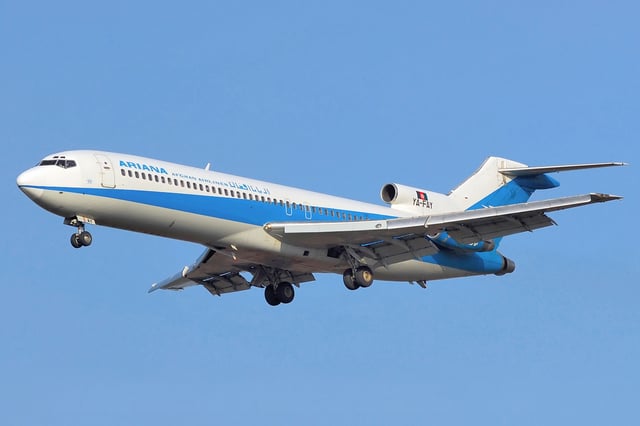
Longer 727-200, of Ariana Afghan Airlines
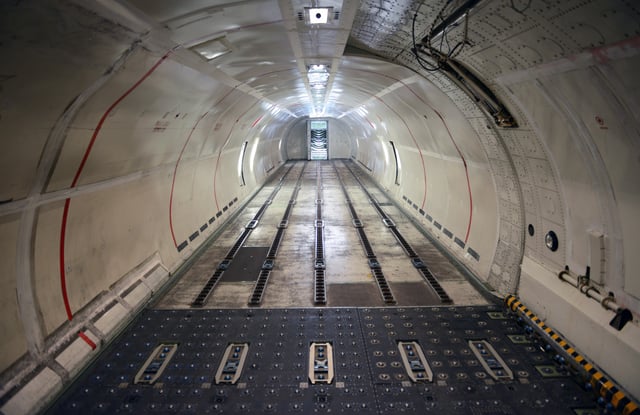
Freighter cargo hold
A stretched version of the 727-100, the -200 is 20 feet (6.1 m) longer (153 feet 2 inches;46.69 m) than the −100 (133 feet 2 inches;40.59 m). A 10-ft (3-m) fuselage section ("plug") was added in front of the wings and another 10-ft fuselage section was added behind them. The wing span and height remain the same on both the −100 and −200 (108 and 34 feet (33 and 10 m), respectively). The original 727-200 had the same maximum gross weight as the 727-100; however, as the aircraft evolved, a series of higher gross weights and more powerful engines was introduced along with other improvements, and from line number 881, 727-200s are dubbed −200 Advanced. The aircraft gross weight eventually increased from 169,000 to 209,500 pounds (76,700 to 95,000 kg) for the latest versions. The dorsal intake of the number-two engine was also redesigned to be round in shape, rather than oval as it was on the -100 series.
The first 727-200 flew on July 27, 1967, and received FAA certification on November 30, 1967. The first delivery was made on December 14, 1967, to Northeast Airlines. A total of 310 727-200s were delivered before its place on the production line was taken over by the 727-200 Advanced in 1972.
- 727-200C
A convertible passenger cargo version, only one was built.
- 727-200 Advanced
The Advanced version of the 727-200 was introduced in 1970.[46] More powerful engines, fuel capacity and MTOW (185,800 to 210,000 lb or 84.4 to 95.3 t) increased the range from 1,930 to 2,550 nmi (3,570 to 4,720 km) or by 32%.[47] After the first delivery in mid-1972, Boeing eventually raised production to more than a hundred a year to meet demand by the late '70s. Of the passenger model of the 727-200 Advanced, a total of 935 were delivered, after which it had to give way to a new generation of aircraft.
- 727-200F Advanced
A freighter version of the 727-200 Advanced became available in 1981 designated the Series 200F Advanced powered by the Pratt & Whitney JT8D-17A engines and featured a strengthened fuselage structure, an 11 ft 2 in (3.40 m) by 7 ft 2 in (2.18 m) forward main deck freight door, and a windowless cabin. This was the last production variant of the 727 to be developed by Boeing, and 15 aircraft were built, all for Federal Express; the last 727 aircraft completed by Boeing was a 727-200F Advanced.
- Super 27
Speed was increased by 50 mph (80 km/h) by replacement of the two side engines with the JT8D-217 or the JT8D-219, which are also found on many MD-80s, along with the addition of hush kits to the center engine. Winglets were added to some of these aircraft to increase fuel efficiency. This modification was originally developed by Valsan Partners, but was later marketed by Quiet Wing Technologies in Redmond, Washington.[48]
- Boeing C-22CA single 727-212 aircraft was operated by the USAF.
Operators
Commercial operators
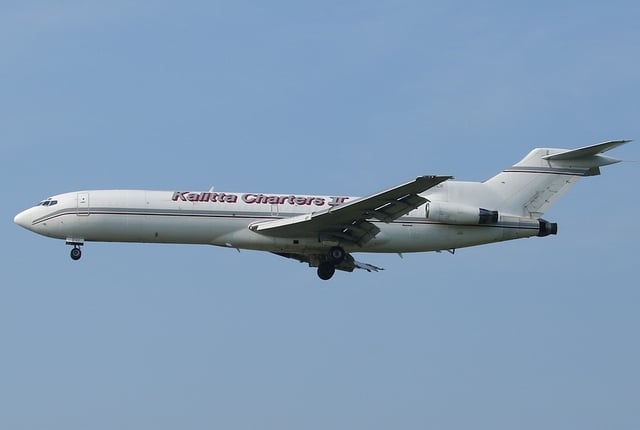
Kalitta Charters is the largest 727 operator with six
As of July 2018, there were 44 Boeing 727s (2 Boeing 727-100s and 42 727-200s) in commercial operation with 23 airlines. Iran Aseman Airlines, the last passenger airline operator, made the last scheduled 727 passenger flight on 13 January 2019.[49] All aircraft remaining in commercial service are used for cargo. These operators have five or more aircraft:[9]
Kalitta Charters (6)
Serve Air (5)
T2 Aviation Ltd uses 2 modified former FedEx 727-200 freighters, operated by 2 Excel Aviation, equipped with oil dispersal tanks and spray booms to respond to oil spills.[50]
Government, military, and other operators
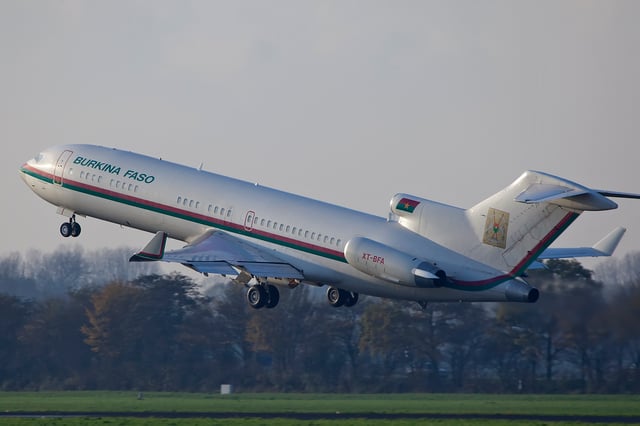
Burkina Faso 727
In addition, the 727 has seen sporadic government use, having flown for the Belgian, Yugoslavian, Mexican, New Zealand, and Panama air forces, among the small group of government agencies that have used it.
Afghan Air Force – Three being acquired from Ariana Afghan Airlines[51]
Military of Benin (1)
Bolivian Air Force (Transporte Aereo Militar) (1)
Presidency of Burkina Faso (1)
Colombian government
Colombian Air Force (2)
Force Aérienne du Congo (4)
Djibouti Air Force (2)[52]
Ecuadorian Air Force (3)
Iraqi government, Salah Aldin (1)
Mexican Air Force (5) retired in 2017
Federal Preventive Police (4)
Royal New Zealand Air Force (3) retired in 2003
Oil Spill Response Limited[43]
United States Air Force – formerly used as a military transport, designated the C-22.
Private aircraft
A number of 727s have been outfitted for use as private aircraft, especially since the early 1990s when major airlines began to eliminate older 727-100 models from their fleet.[53] Donald Trump traveled in a former American Airlines 727-100 with dining room, bedroom and shower facilities before upgrading to a larger Boeing 757 in 2009;[54] Peter Nygård acquired a 727-100 for private use in 2005.[55] American Financier Jeffrey Epstein owned a private 727 nicknamed the "Lolita Express".[56]
Accidents and incidents
Orders and deliveries
| Year | Total | 1984 | 1983 | 1982 | 1981 | 1980 | 1979 | 1978 | 1977 | 1976 | 1975 | 1974 | 1973 |
|---|---|---|---|---|---|---|---|---|---|---|---|---|---|
| Orders | 1,831 | 0 | 1 | 11 | 38 | 68 | 98 | 125 | 133 | 113 | 50 | 88 | 92 |
| Deliveries | 1,831 | 8 | 11 | 26 | 94 | 131 | 136 | 118 | 67 | 61 | 91 | 91 | 92 |
| Year | 1972 | 1971 | 1970 | 1969 | 1968 | 1967 | 1966 | 1965 | 1964 | 1963 | 1962 | 1961 | 1960 |
|---|---|---|---|---|---|---|---|---|---|---|---|---|---|
| Orders | 119 | 26 | 48 | 64 | 66 | 125 | 149 | 187 | 83 | 20 | 10 | 37 | 80 |
| Deliveries | 41 | 33 | 55 | 114 | 160 | 155 | 135 | 111 | 95 | 6 | 0 | 0 |
Source: Data from Boeing, through the end of production[59]
Boeing 727 orders and deliveries (cumulative, by year):
Orders
Deliveries
Aircraft on display
N7001U – 727-022 on static display at the Museum of Flight in Seattle, Washington. It was the first 727 completed. It departed from Paine Field in Everett, Washington and landed at the museum on March 2, 2016.[62][63]
N7017U – 727 on static display at the Museum of Science and Industry in Chicago, Illinois. It was donated by United Airlines who operated it as N7017U. It features cut away sections showing airplane framework and lavatory, cockpit view, and a few rows of seating.[64][65]
N186FE – 727-100 on static display at Owens Community College in Perrysburg, Ohio. It formerly operated by FedEx as N186FE and donated by the company in 2007.[66][67]
N117FE – 727-123F on static display with Middle Tennessee State University at Murfreesboro Municipal Airport in Murfreesboro, Tennessee. It was formerly operated by FedEx as N117FE.[68][69]
N199FE – 727-173C on static display at the Kansas Aviation Museum in Wichita, Kansas. It was formerly operated by FedEx as N199FE.[70][71]
N113FE Jarrod – 727-022C in storage at the National Museum of Commercial Aviation in Atlanta, Georgia. It was formerly operated by FedEx as N113FE, and by United Airlines before that as N7437U.[72]
N265SE Paul – 727-200 on static display at the Florida Air Museum in Lakeland, Florida. It was formerly operated by FedEx as N265FE.[73][74]
N492FE Two Bears – 727-227 on static display with the University of Alaska at Merrill Field in Anchorage, Alaska. It was formerly operated by FedEx as N492FE and was donated by the company on February 26, 2013.[75][76][77][78]
N874AA – 727-223 stored for the Airline History Museum at Boeing Field in Seattle, Washington.[79]
G-BNNI Lady Patricia – 727-276 last flown by Sabre Airways in 2000. Purchased by 727 Communications, an advertising company in Skanderborg, Denmark, it now serves as a conference room and billboard at their offices.[80][81]
Specifications

A comparison of the different 727 variants
| Variant | 727-100 | 727-200 |
|---|---|---|
| Flight crew[83] | three: pilot, copilot, and flight engineer | |
| Two-class seats | 106: 16F@38", 90Y@34" | 134: 20F@38", 114Y@34" |
| One-class seats | 125@34" | 155@34" |
| Exit limit[83] | 131 | 189 |
| Length | 133ft2in / 40.59m | 153ft2in / 46.68m |
| Height | 34ft3in / 10.44m | 34ft11in / 10.65m |
| Cabin width | 140in / 3.56m | |
| Wingspan | 108 ft / 32.92m | |
| Wing[47] | 1,650 sq ft (153 m2), 32° sweep | |
| MTOW | 169,000 lb / 76,700 kg | 172,000 lb / 78,100 kg Adv. 209,500 lb / 95,100 kg |
| OEW | 87696 lb / 39,800 kg | 97,650 lb / 44,330 kg Adv. 100,700 lb / 45,720 kg |
| Fuel capacity | 7,680gal / 29,069L | 8,090USgal / 30,620L Adv. 10,585USgal / 40,060L |
| Engines ×3 | Pratt & Whitney JT8D-1/7/9 | JT8D-7/9/11 (Adv.: -9/15/17/17R) |
| Thrust ×3 | 14,000–14,500 lbf (62–64 kN) | 14,000–15,000 lbf (62–67 kN) Adv. 14,500–17,400 lbf (64–77 kN) |
| Range[3] | 2,250 nmi (4,170 km) | 1,900 nmi (3,500 km) Adv. 2,550 nmi (4,720 km) |
| Take-off[4] | 8,300 ft (2,500 m) | 8,400 ft (2,600 m) Adv. 10,100 ft (3,100 m) |
| MMO[83] | Mach 0.9 (961 km/h; 519 kn) | |
| Cruise | 495 kn/ 917 km/h / Mach 0.86[84] | 865–953 km/h / 467-515kt [85] |
| Ceiling[83] | 42,000 ft (13,000 m) | |
See also
2012 Boeing 727 crash experiment
Notable appearances in media
Related development
Boeing 7J7
Aircraft of comparable role, configuration and era
Hawker Siddeley Trident
BAC One-Eleven
McDonnell Douglas DC-9
Tupolev Tu-154
Related lists
List of civil aircraft
List of jet airliners